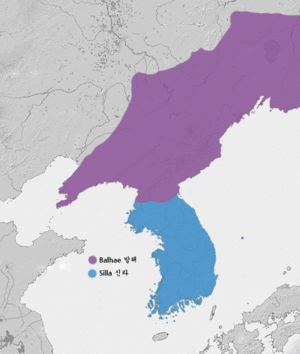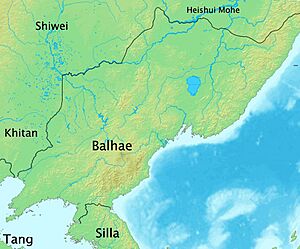Northern and Southern States period facts for kids
| Northern and Southern States period | |
 |
|
Quick facts for kids Korean name |
|
|---|---|
| Hangul |
남북국시대
|
| Hanja |
南北國時代
|
| Revised Romanization | Nambukguksidae |
| McCune–Reischauer | Nambukkuksidae |
The Northern and Southern States period (698–926 CE) was a time in ancient Korean history. During this period, two important kingdoms existed at the same time. Unified Silla was in the south of the Korean peninsula. Balhae was in the north.
Contents
How Historians See This Period
This period is important because it helps us understand Korean identity. It includes Balhae as a key part of Korean history. The name "Northern and Southern States period" was created by a scholar named Yu Deuk-gong (1749–1807) during the Joseon era.
Yu Deuk-gong wrote a book called Balhaego. In this book, he suggested a new way to look at Korean history. He believed that Balhae should be included. He thought that losing control of Manchuria was a main reason for Joseon's problems.
Later, in the 1960s, a North Korean scholar named Pak Se-yong said that Balhae was part of Korean history. He argued that Balhae was founded by people from Goguryeo. He also said its land included most of Goguryeo's old territory.
Around the same time, Chu Yŏnghŏn in South Korea also supported the idea that Balhae was Korean. This was based on discoveries from joint archaeological digs. These efforts led to Balhae being included in Korean history. This new way of thinking is called the "Northern and Southern Dynasties."
This idea became widely accepted in South Korea. Scholars like Kim Eun Gug said it was important to counter claims from China. China sometimes says that Goguryeo and Balhae are part of Chinese history. Including Balhae helps show the long history of the Korean people. It also offers a model for how North and South Korea might unite in the future.
Unified Silla: A Golden Age
After many wars, Silla managed to unite most of the Three Kingdoms. They drove out the Tang dynasty forces by 676 CE. This created Unified Silla.
Unified Silla was a time of great art and culture. Buddhism became a very important part of Silla life. Famous Buddhist temples like the Bulguksa show amazing Korean architecture. Other important sites include Hwangnyongsa Temple and Bunhwangsa Temple. The Seokguram Grotto is also from this time. It is now a World Heritage Site.
Unified Silla was also strong at sea. They continued the maritime skills of Baekje. During the 8th and 9th centuries, Silla ships controlled the seas of East Asia. They traded a lot between China, Korea, and Japan. A famous figure was Jang Bogo, who led much of this trade. Silla people even set up communities in China.
Unified Silla was a very rich and successful country. Its capital city, Gyeongju, was one of the largest cities in the world. Buddhism thrived during this time. Many Korean Buddhist monks became famous in China. They helped shape Chinese Buddhism.
However, Unified Silla started having political problems in the late 9th century. This made the kingdom weak. Soon, people from the old Baekje kingdom started a new kingdom called Later Baekje. In the north, rebels brought back Goguryeo. This began the Later Three Kingdoms period.
Unified Silla lasted for 267 years. It was eventually taken over by Goryeo in 935 CE.
Balhae: The Northern Kingdom
Balhae was founded after the fall of Goguryeo. Its founder was Dae Joyeong. He was a former Goguryeo general or a chief of the Sumo Mohe tribe. He defeated the Tang dynasty army at the Battle of Tianmenling.
Balhae controlled the northern parts of the Korean Peninsula. It also held much of Manchuria and even parts of present-day Russia. This kingdom enjoyed a time of peace and stability. Its culture grew, especially under the long rule of King Mun (737–793 CE) and King Seon.
Balhae was a very advanced country culturally. China even called it "a prosperous country of the East." But by the 10th century, Balhae became weak. The Khitan Liao dynasty conquered Balhae in 926 CE.
Goryeo took over some of Balhae's land. It also welcomed many Balhae refugees, including the crown prince and the royal family. However, Goryeo did not keep many records about Balhae's history.
What About Their Languages?
It is hard to know for sure how the languages of Balhae and Silla were related. This is because there is not much evidence left.
One word that people in Balhae used for "a king" was Gadokbu.
See also
- History of Korea
- Military history of Korea


